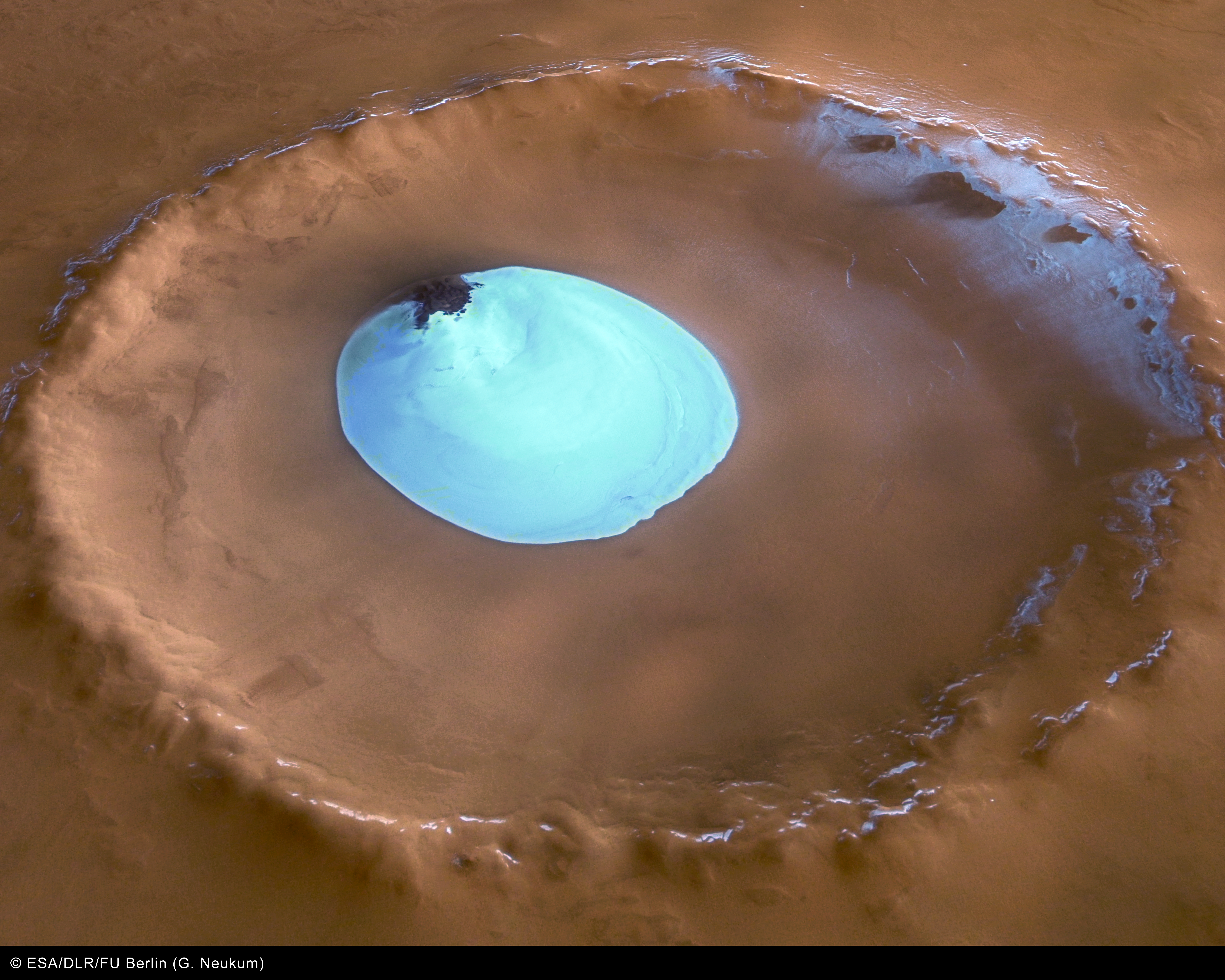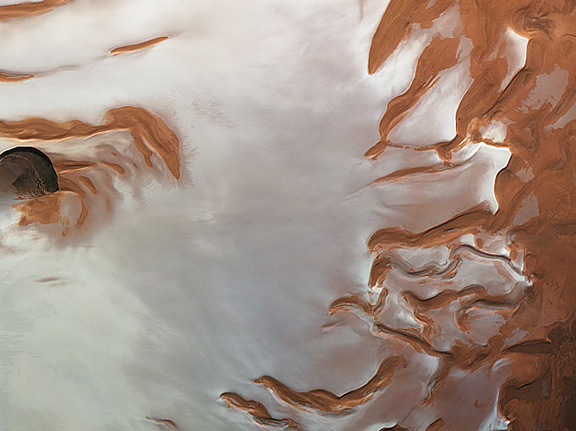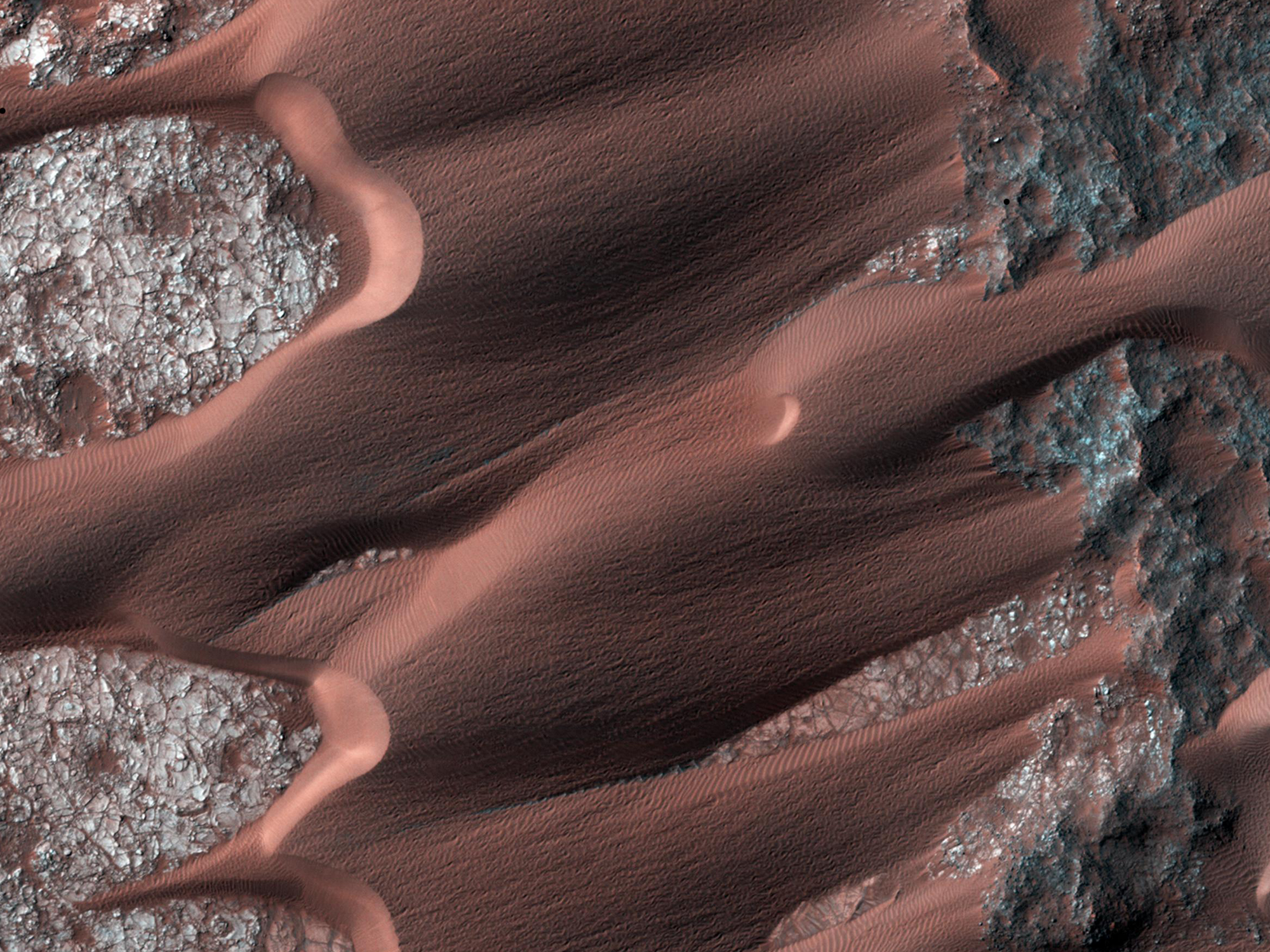
Hydrology
Liquid water cannot exist on the surface of Mars due to low atmospheric pressure, except at the lowest elevations for short periods. The two polar ice caps appear to be made largely of water. The volume of water ice in the south polar ice cap, if melted, would be sufficient to cover the entire planetary surface to a depth of 11 meters. A permafrost mantle stretches from the pole to latitudes of about 60°.
Large quantities of water ice are thought to be trapped within the thick cryosphere of Mars. Radar data from Mars Express and the Mars Reconnaissance Orbiter show large quantities of water ice both at the poles (July 2005) and at mid-latitudes (November 2008). The Phoenix lander directly sampled water ice in shallow Martian soil on July 31, 2008.

Landforms visible on Mars strongly suggest that liquid water has at least at times existed on the planet’s surface. Huge linear swathes of scoured ground, known as outflow channels, cut across the surface in around 25 places. These are thought to record erosion which occurred during the catastrophic release of water from subsurface aquifers, though some of these structures have also been hypothesised to result from the action of glaciers or lava. One of the larger examples, Ma’adim Vallis is 700 km long and much bigger than the Grand Canyon with a width of 20 km and a depth of 2 km in some places. It is thought to have been carved by flowing water early in Mars’s history. The youngest of these channels are thought to have formed as recently as only a few million years ago. Elsewhere, particularly on the oldest areas of the Martian surface, finer-scale, dendritic networks of valleys are spread across significant proportions of the landscape. Features of these valleys and their distribution very strongly imply that they were carved by runoff resulting from rain or snow fall in early Mars history. Subsurface water flow and groundwater sapping may play important subsidiary roles in some networks, but precipitation was probably the root cause of the incision in almost all cases.
There are also thousands of features along crater and canyon walls that appear similar to terrestrial gullies. The gullies tend to be in the highlands of the southern hemisphere and to face the Equator; all are poleward of 30° latitude. A number of authors have suggested that their formation process demands the involvement of liquid water, probably from melting ice, although others have argued for formation mechanisms involving carbon dioxide frost or the movement of dry dust. No partially degraded gullies have formed by weathering and no superimposed impact craters have been observed, indicating that these are very young features, possibly even active today.
Other geological features, such as deltas and alluvial fans preserved in craters, also argue very strongly for warmer, wetter conditions at some interval or intervals in earlier Mars history. Such conditions necessarily require the widespread presence of crater lakes across a large proportion of the surface, for which there is also independent mineralogical, sedimentological and geomorphological evidence. Some authors have even gone so far as to argue that at times in the Martian past, much of the low northern plains of the planet were covered with a true ocean hundreds of meters deep, though this remains controversial.

Further evidence that liquid water once existed on the surface of Mars comes from the detection of specific minerals such as hematite and goethite, both of which sometimes form in the presence of water. Some of the evidence believed to indicate ancient water basins and flows has been negated by higher resolution studies by the Mars Reconnaissance Orbiter. In 2004, Opportunity detected the mineral jarosite. This forms only in the presence of acidic water, which demonstrates that water once existed on Mars. More recent evidence for liquid water comes from the finding of the mineral gypsum on the surface by NASA’s Mars rover Opportunity in December 2011. Additionally, the study leader Francis McCubbin, a planetary scientist at the University of New Mexico in Albuquerque looking at hydroxals in crystalline minerals from Mars states the amount of water in the upper mantle of Mars is equal to or greater than that of Earth at 50–300 parts per million of water, which is enough to cover the entire planet to a depth of 200 to 1000 meters.
On March 18, 2013, NASA reported evidence from instruments on the Curiosity rover of mineral hydration, likely hydrated calcium sulfate, in several rock samples including the broken fragments of “Tintina” rock and “Sutton Inlier” rock as well as in veins and nodules in other rocks like “Knorr” rock and “Wernicke” rock. Analysis using the rover’s DAN instrument provided evidence of subsurface water, amounting to as much as 4% water content, down to a depth of 60 cm (2.0 ft), in the rover’s traverse from the Bradbury Landing site to the Yellowknife Bay area in the Glenelg terrain.